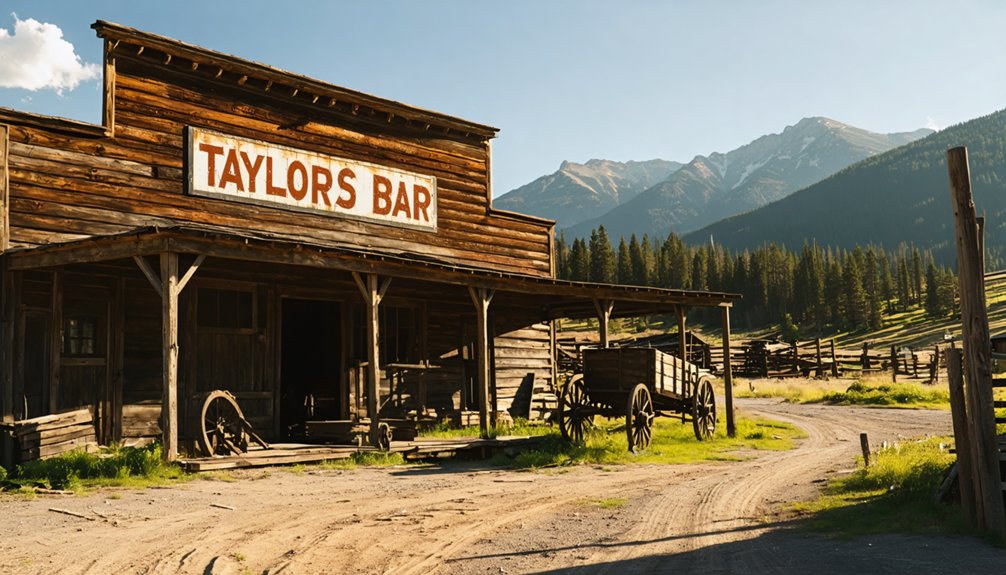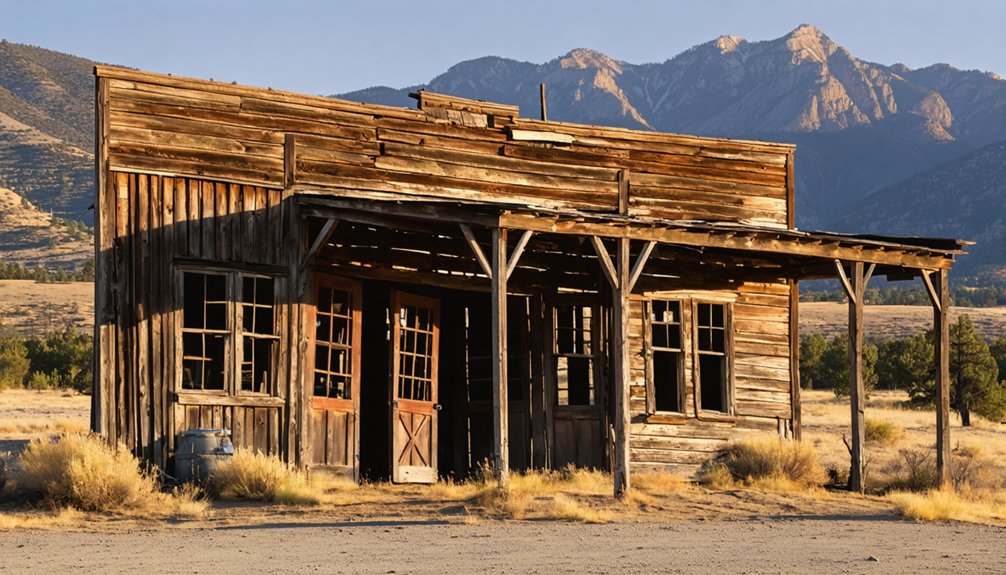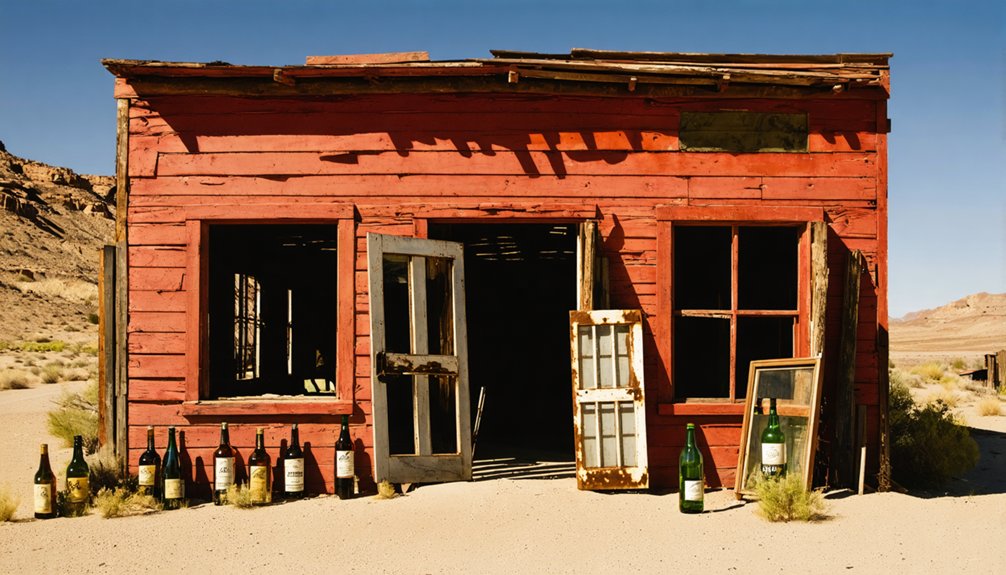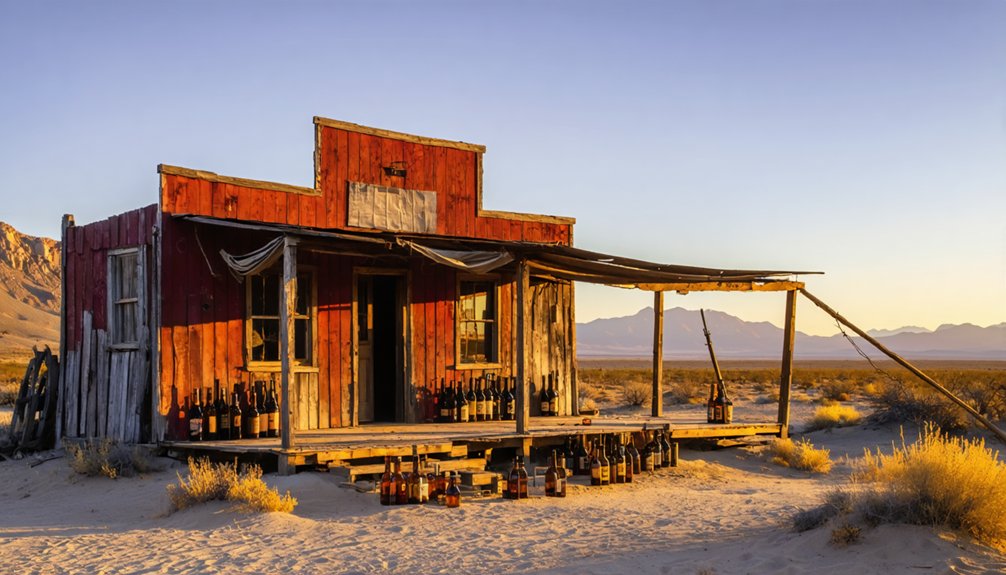Taylors Bar emerged during California’s Gold Rush as a mining settlement along the Calaveras River. You’ll find it named after E.S. “Black” Taylor, a half-Cherokee prospector who partnered with Waterman Bodey. The camp flourished briefly with tent dwellings and rudimentary mining operations before advanced quartz milling technology arrived in 1881. Today, nature has reclaimed most structures, leaving only scattered stone foundations and fragments as silent witnesses to this once-bustling frontier community’s rich heritage.
Key Takeaways
- Taylors Bar emerged during the California Gold Rush as a mining settlement with populations fluctuating based on gold discovery and depletion.
- The ghost town was named after E.S. “Black” Taylor, a half-Cherokee prospector who partnered with Waterman S. Bodey in early mining operations.
- A significant quartz mill built in 1881 and a 2.5-mile water ditch system transformed Taylors Bar’s mining capabilities.
- Today, only scattered stone foundations and deteriorated fragments of structures like the Gothic chapel remain at the site.
- Preservation efforts face challenges balancing environmental restoration with historical conservation of this Gold Rush era settlement.
The Origin Story of Taylors Bar Mining Camp
While the exact founding date remains unclear in historical records, Taylors Bar emerged as a small mining camp during the fervor of the California Gold Rush, when prospectors established temporary settlements almost overnight across the Sierra Nevada region.
You’ll find that Taylors Bar’s ghost town history mirrors the typical pattern of boom-and-bust cycles that characterized this era. The settlement consisted primarily of tents and rudimentary cabins, housing a transient population of miners who employed early mining technology like panning and sluicing to extract placer gold from the river’s gravel bars.
Strategic waterway placement was vital, as miners diverted streams to access gold-rich sediments. Unlike Angels Camp which was established in 1848, Taylors Bar never achieved the same permanence or historical recognition. Like neighboring camps, Taylors Bar attracted a diverse population whose numbers fluctuated with the discovery and depletion of local gold deposits. Similar to Middle Bar, which experienced a significant population decline by 1880, Taylors Bar saw its residents gradually leave as mining opportunities diminished.
E.S. “Black” Taylor: The Man Behind the Name
E.S. “Black” Taylor, a half-Cherokee prospector who partnered with Waterman S. Bodey during their momentous gold discovery, represents an often-overlooked figure in California’s mining history.
You’ll find Taylor’s legacy intertwined with his compassionate return to bury Bodey’s remains after the latter perished in a devastating blizzard during their expedition.
His remarkable resilience enabled him to withstand the harsh Sierra winters, maintaining mining operations at what would become one of California’s most notorious boomtowns. Taylor’s rich gold strike in 1859 laid the foundation for Bodie’s eventual transformation into a thriving mining community. As historians strive to separate fact from fiction, Taylor’s story deserves to be told with reliable sources rather than perpetuating potentially sensationalized accounts.
Half-Cherokee Mining Pioneer
Among the colorful figures of California’s gold rush era, E.S. “Black” Taylor stands out as a particularly significant frontier character whose half-Cherokee heritage marked him as an uncommon indigenous presence in early mining history.
You’ll find Taylor’s cultural heritage deeply intertwined with the frontier mining narrative near Mono Lake, where he partnered with Waterman S. Body in 1859. Unlike many indigenous people who were displaced by mining operations, Taylor actively participated in the gold economy, bringing his unique perspective to the early California mining landscape.
His indigenous contributions remain evident in the physical geography of the region, with Taylor Gulch bearing his name to this day. Though often overshadowed by Body in historical accounts, Taylor’s persistence helped sustain mining operations through harsh conditions until larger industrial ventures took hold. The area where they made their discovery would eventually become known as Bodie rather than Bodey due to a sign painter’s error, changing the intended spelling of the town’s name. Despite Taylor’s diligent efforts, the severe weather conditions of the region claimed the life of his partner when Bodey froze to death in a November blizzard while returning from gathering supplies.
Bodey’s Burial Companion
Taylor’s role in California mining history extends far beyond his cultural heritage into a fateful partnership with Waterman S. Bodey. When the two were caught in a devastating blizzard during an 1859 supply trip to Monoville, tragedy struck as Bodey froze to death after they became separated.
You’ll find Taylor’s contribution to Bodey’s legacy particularly significant in the aftermath. When spring thawed the frozen landscape, Taylor returned to locate his partner’s remains.
With help from fellow miners including Johnson King, he conducted a solemn burial, despite finding Bodey’s body stripped and scattered by the elements. This discovery reflected the harsh Sierra Nevada conditions that claimed many prospectors’ lives during the Gold Rush era.
This act of loyalty cemented Taylor’s place in Bodie’s founding narrative. While historical records have corrected myths about his role in the initial gold discovery, his commitment to honoring his fallen companion remains an enduring tribute to frontier brotherhood.
Surviving Sierra Winters
While the discovery of gold brought prospectors flocking to the Eastern Sierra region, surviving the brutal winter months presented challenges that tested even the most resilient miners. E.S. “Black” Taylor’s experience during the winter of 1859-1860 exemplifies these harsh realities.
After Bodey froze to death during a supply trip to Monoville, Taylor’s survival strategies became vital to maintaining mining operations.
You’ll find that winter hardships in the Sierra Nevada were life-threatening – isolation, starvation, and hypothermia claimed many lives.
Taylor’s half-Cherokee heritage may have contributed to his resilience against these elements. His ability to endure extreme conditions while managing claims through brutal winters proved instrumental to Bodie’s eventual development.
Unlike many who abandoned their claims when faced with Sierra’s unforgiving climate, Taylor’s perseverance guaranteed continuity at the nascent mining camp.
Gold Mining Operations and Economic Activities
You’ll discover that Taylors Bar’s mining operations underwent significant logistical transformation as ore transport methods evolved from manual carrying to more sophisticated systems.
The construction of a substantial mill in 1881 marked a pivotal advancement in the area’s gold processing capabilities, allowing miners to process larger quantities of ore more efficiently.
This infrastructure development reflected the settlement’s economic maturation and commitment to capitalizing on the region’s continuing mineral wealth despite the waning of initial placer mining opportunities.
Taylors Bar was one of several rich bars discovered during the California Gold Rush, alongside other notable locations such as Smith, Indian, and Missouri Bar.
The mining techniques at Taylors Bar evolved from simple panning to more complex placer mining methods with cradles and rockers, similar to the progression seen throughout California’s gold fields.
Ore Transport Evolution
Mining settlements throughout California’s gold country experienced remarkable changes in ore transport methods as operations matured from simple placer mining to more complex extraction systems.
While specific details about Taylors Bar’s ore transport infrastructure remain elusive in historical records, you’d find that mining logistics throughout the region typically evolved from rudimentary methods to increasingly sophisticated systems.
Initially, miners likely carried ore in simple pans and sluice boxes, eventually progressing to more elaborate transport networks as settlements developed.
The evolution of ore transport often paralleled the shift from individual prospecting to company-operated hydraulic mining operations.
As mining deepened and expanded, primitive hand-carrying methods gave way to mule trains, wagons, and eventually mechanical systems that could move larger quantities of material more efficiently.
The discovery of extraordinarily rich gold diggings at nearby Big Bar in the late 1840s likely influenced transportation developments throughout the region.
Mill Construction 1881
The year 1881 marked a watershed moment in Taylors Bar’s development with the construction of a substantial quartz mill that fundamentally altered the settlement’s economic landscape.
You’d have witnessed the consolidation of several mining claims into a more efficient operation, creating economies of scale previously unattainable when claims operated independently.
This advanced mill technology incorporated water-powered stamp mills, mercury amalgamation plates, and retort systems—representing significant capital investment while dramatically increasing ore processing capacity.
The mining infrastructure included a sophisticated 2.5-mile ditch system that transported water through carefully engineered gravity-fed channels.
Specialized workers managed different aspects of the operation, from foremen overseeing extraction to technicians handling the delicate mercury recovery process, creating a hierarchical but interdependent workforce that maximized production efficiency.
Daily Life in a Sierra County Mining Settlement

Life in a Sierra County mining settlement during the gold rush era revolved around practicality and impermanence, as evidenced by the rudimentary dwellings that dotted the landscape. You’d find miners residing in hastily constructed shanties and tents, with settlement architecture prioritizing proximity to claims over comfort.
The mining community operated on collaborative principles, with groups working together to divert waterways and construct essential infrastructure. Your daily existence would center around intense physical labor, with weeks spent building ditches and water systems necessary for placer mining operations.
When not working claims, you might supplement your livelihood through small-scale farming and ranching. Social gatherings were informal, occurring at trading centers that served as community hubs.
Despite the transient nature of these settlements, a rich diversity of immigrants created unique cultural tapestries throughout Sierra County.
Transport and Connectivity: From Ore to Market
Transportation networks in Taylors Bar evolved from primitive waterways to established roads, fundamentally shaping the economic viability of mining operations throughout the region.
You’d find miners initially relying on ferries like the “whale boat” near Big Bar to transport valuable ore across the Calaveras River by 1849.
These river crossings became natural gathering points, spawning settlements offering essential services.
The Rise and Fall of a California Boomtown

When you examine Taylors Bar’s explosive emergence during the Gold Rush, you’ll notice its rapid transformation from a riverside mining camp to a bustling commercial center with stores, saloons, and boarding houses.
The town’s prosperity peaked as mining operations yielded substantial returns, supporting a diverse population that included Chinese immigrants and creating a frontier economy complete with essential services and entertainment venues.
As mines eventually flooded or became unprofitable in the 1880s, you’ll find Taylors Bar followed the classic boomtown-to-ghost-town trajectory, with disasters like fires and floods hastening its abandonment as miners sought opportunities elsewhere.
Gold Fever Strikes
The discovery of gold at Taylors Bar in 1848, occurring shortly after James Marshall’s momentous find at Sutter’s Mill, ignited a frenzied migration that would transform this quiet stretch of the Mokelumne River into a bustling boomtown within weeks.
You’d have witnessed hundreds of fortune-seekers descending upon this prime placer mining location, staking claims and feverishly washing river gravels for precious metal.
The gold rush’s allure proved irresistible, drawing prospectors from across California and beyond.
Within months, Taylors Bar erupted with tents, shanties, and crude cabins, while entrepreneurial spirits established essential services—stores, saloons, and gambling houses.
The mining legacy of this site exemplifies the quintessential boom-and-bust cycle that characterized countless California settlements, where freedom-seeking individuals gambled everything on the prospect of instant wealth.
Mining Boom Prosperity
As Taylors Bar evolved from a chaotic assemblage of tents into a structured settlement, technological advancements dramatically reshaped its mining landscape and economic trajectory.
You’d witness the shift as dynamite, square-set timbering, and steam-powered drills replaced primitive extraction methods. The introduction of cyanidation in 1896 revolutionized gold recovery efficiency, while electrification reduced operational costs.
These mining innovations attracted substantial foreign capital, moving operations from independent prospectors to wage laborers employed by well-financed companies. Labor dynamics changed fundamentally as the profitable processing of lower-grade ore deposits demanded industrial-scale operations.
The town’s prosperity manifested in multiple twenty-to-thirty stamp mills, though ironically, few original prospectors achieved wealth. Most either shifted to wage work or departed, leaving behind the infrastructure that would eventually decay when resources depleted.
Abandoned Dreams Remain
Beneath the facade of industrial prosperity, Taylors Bar’s eventual decline began taking shape even during its most productive years. The abandoned aspirations of countless miners and entrepreneurs now echo through empty structures and weathered remnants.
You’ll find that economic diversification never materialized beyond extractive industries, leaving the community vulnerable when mineral yields inevitably diminished. Lost opportunities to establish sustainable commerce created a precarious dependency on exhaustible resources.
- Dilapidated mining equipment stands as evidence of technological obsolescence
- Abandoned homesteads reflect population exodus following resource depletion
- Empty storefronts along main thoroughfares chronicle commercial collapse
- Eroding infrastructure demonstrates lack of municipal reinvestment
- Weathered cemetery markers document human cost of boom-and-bust economics
Environmental Challenges and Frontier Survival

Life in Taylors Bar during the gold rush era presented extraordinary environmental challenges that tested settlers’ resilience and ingenuity daily.
You’d face devastating environmental impacts from hydraulic mining, which ravaged watersheds and triggered massive erosion. Contaminated water sources threatened your health, while deforestation stripped the landscape of essential resources.
Your survival tactics would necessarily evolve with the seasons. You’d hunt game, forage wild plants, and establish rudimentary trade networks despite your isolation. During harsh winters, you’d face limited medical care and unreliable supply chains. Community cooperation became your lifeline—sharing resources, knowledge, and protection against the elements.
The frontier existence demanded constant adaptation. You’d develop techniques to filter contaminated water, construct shelters from available materials, and establish informal governance systems when official structures failed.
These innovations enabled persistence despite nature’s unforgiving challenges.
Comparing Taylors Bar to Other Ghost Towns of the Era
While Taylors Bar exemplified many common frontier challenges, its development and fate mirrored a pattern visible across dozens of similar settlements that dotted California’s gold country.
Mining camp similarities emerged particularly when comparing Taylors Bar to Big Bar, where early settlement patterns followed the same river-based extraction model that dominated the 1848-1855 period.
The arc of California’s gold camps followed predictable rhythms of ambition, extraction, and eventual abandonment.
- Emergence during peak gold rush migration (1852) paralleled numerous Calaveras region settlements
- Transportation development through privately financed roads connecting to commercial centers
- Population demographics consisting primarily of transient miners lacking permanent family structures
- Abandonment triggered by declining gold yields within a decade of establishment
- Infrastructure patterns featuring early trading posts that evolved to support mining operations
Ghost town comparisons reveal how Taylors Bar wasn’t unique in its lifecycle but rather representative of California’s boom-and-bust frontier experience.
What Remains Today: Exploring the Ghost Town Site

Visitors to Taylors Bar today encounter a site largely reclaimed by nature, where the once-bustling mining settlement has faded into the landscape. Few remnant structures survive beyond scattered stone foundations and reused blocks that once formed the town’s buildings.
The Gothic chapel, Naples Hotel, and Wells Fargo barn exist only as deteriorated fragments, with survey markers providing the clearest indication of the original town layout.
Your experience at the site involves traversing open, windswept grasslands rather than exploring intact historic buildings. While accessible via road near Highway 101, the location lacks interpretive signage or formal preservation.
Exercise caution when examining the limited architectural remains, as unstable ruins and hidden debris pose potential hazards in this undeveloped landscape where freedom from modern encroachment remains the site’s defining characteristic.
Preserving the Legacy of California’s Mining Heritage
California’s rich mining heritage presents a complex preservation challenge that balances environmental restoration with historical conservation. When you visit sites like Taylors Bar, you’re witnessing the intersection of ecological recovery and cultural preservation efforts established through regulatory frameworks like SMARA.
California’s mining legacy demands a delicate balance between healing scarred landscapes and preserving the artifacts of our industrial past.
The state’s approach combines remediation of environmental damage with protection of historically significant structures.
- National Heritage Areas preserve mining structures while educating visitors about historical contexts
- Remediation techniques like bat gates and cupolas secure dangerous mine features while respecting historical integrity
- Community involvement influences 60% of mining preservation decisions
- The California Truth and Healing Council addresses Gold Rush-era injustices against Native Americans
- Sites like Empire Mine State Park maintain authentic mining heritage while ensuring public safety
Frequently Asked Questions
Are There Any Documented Supernatural Occurrences at Taylors Bar?
Like an empty ledger awaiting entries, there aren’t any documented ghost sightings at Taylors Bar. Historical records show no paranormal investigations or supernatural occurrences have been formally recorded at this location.
What Happened to Taylor’s Descendants After the Town’s Abandonment?
You’ll find limited descendant stories documented; Taylor family legacies likely dissolved into regional migrations. They presumably relocated to nearby mining communities, urban centers, or agricultural areas when economic necessities compelled their departure.
Were Any Notable Gold Nuggets or Treasures Discovered There?
You won’t find notable gold nuggets or treasures at Taylors Bar in historical records. Gold discoveries there were relatively modest compared to major sites like Carson Hill or Spanish Dry Diggings during treasure hunting expeditions.
Did Any Famous Outlaws or Celebrities Ever Visit Taylors Bar?
Ninety percent of Gold Rush legends remain unverified. You’ll find no documented outlaw sightings or celebrity rumors at Taylors Bar in historical records, leaving this aspect of its history analytically inconclusive.
Are There Guided Tours or Annual Events at the Site Today?
No formal guided exploration or historical reenactments currently exist at the site. Unlike Bodie State Historic Park nearby, Taylors Bar lacks established tour infrastructure or documented annual commemorative events.
References
- http://www.bodiehistory.com/myths.htm
- https://en.wikipedia.org/wiki/List_of_ghost_towns_in_California
- https://www.calaverashistory.org/james-bar-lower-bar
- https://discover.hubpages.com/travel/Ghost-Towns-in-California
- https://forgottennevada.org/sites/taylor.html
- https://www.calaverashistory.org/middle-bar
- https://westernmininghistory.com/towns/california/angels-camp/
- https://ohp.parks.ca.gov/?page_id=21392
- https://historymatters.gmu.edu/d/6516/
- https://kids.kiddle.co/Taylors_Bar



